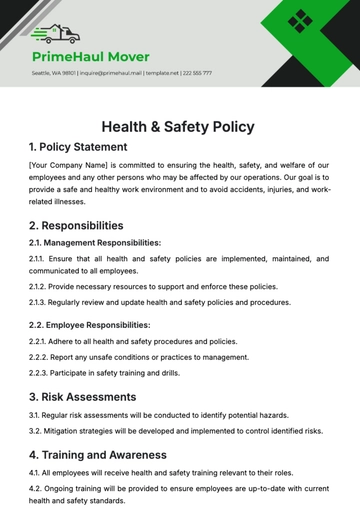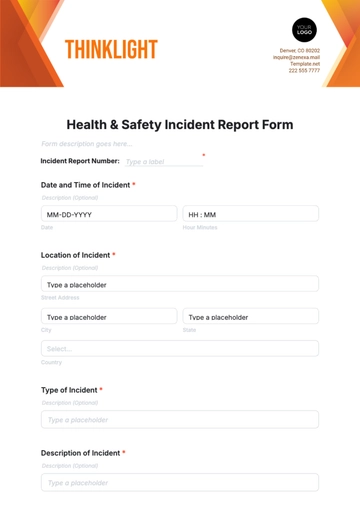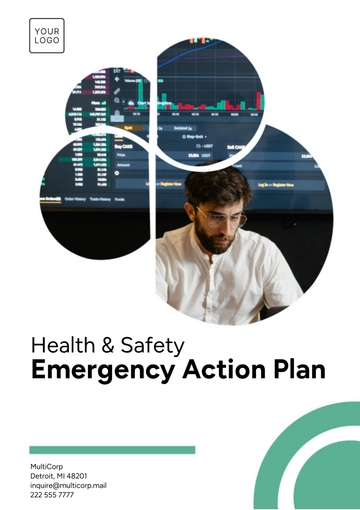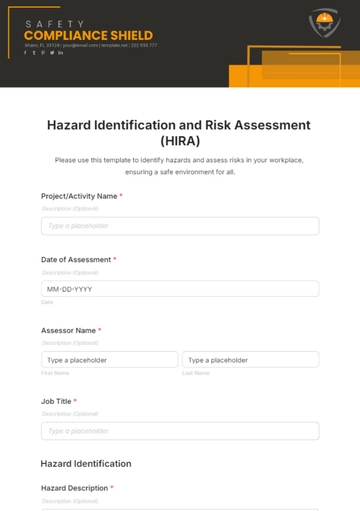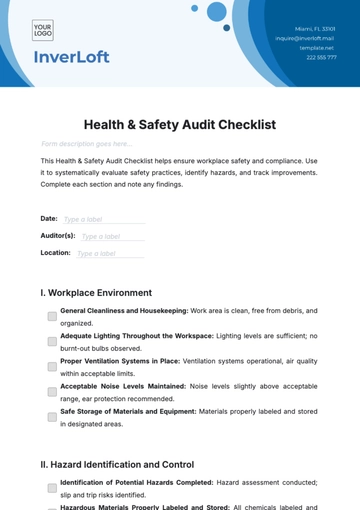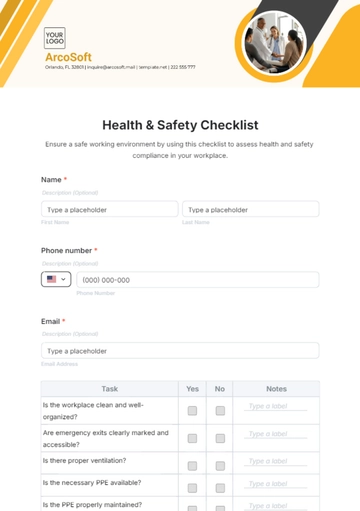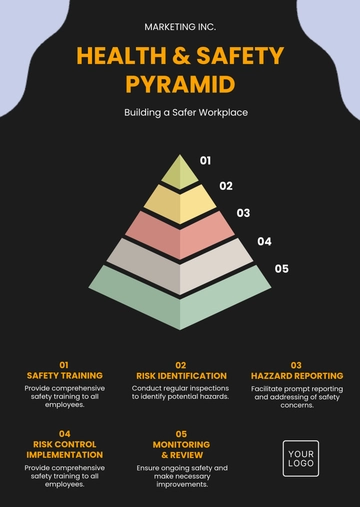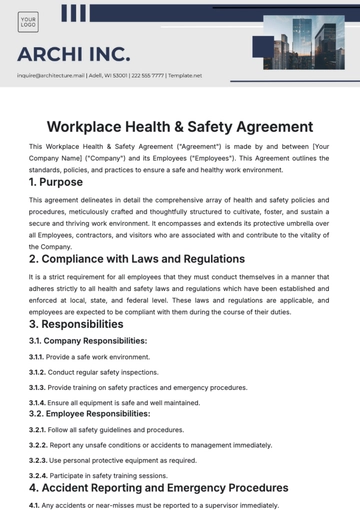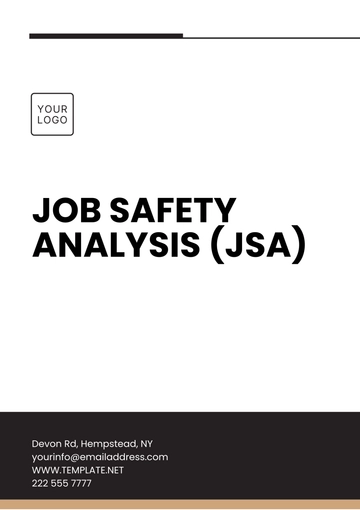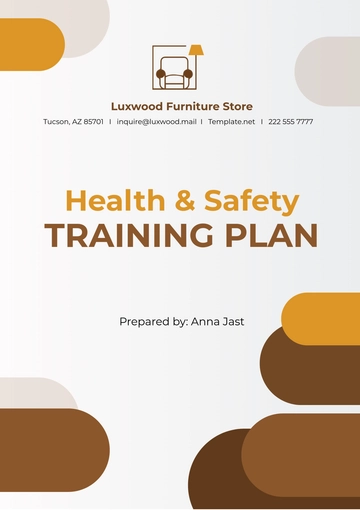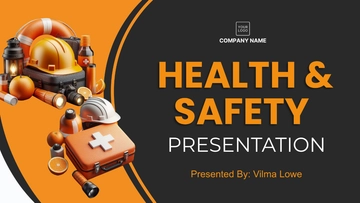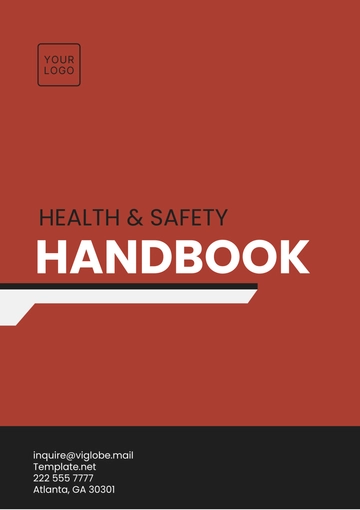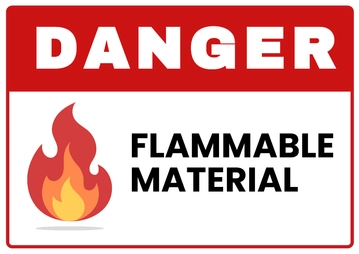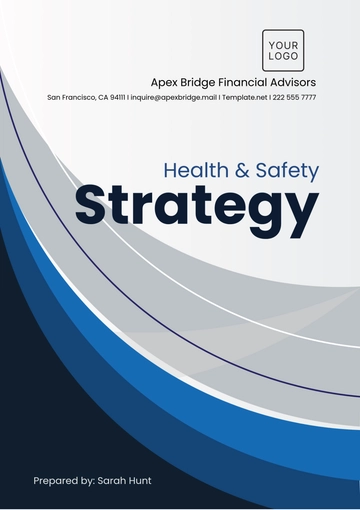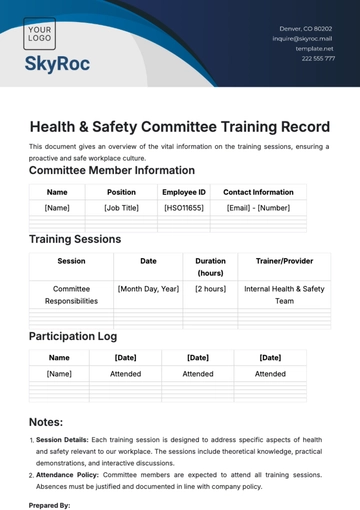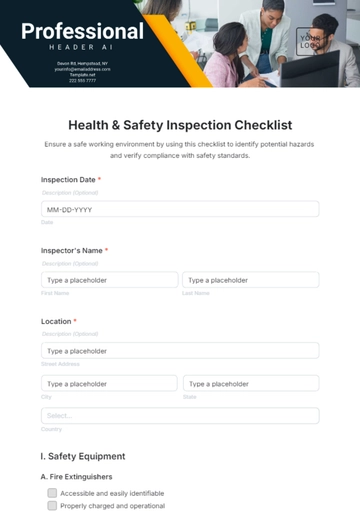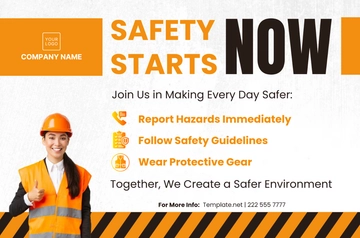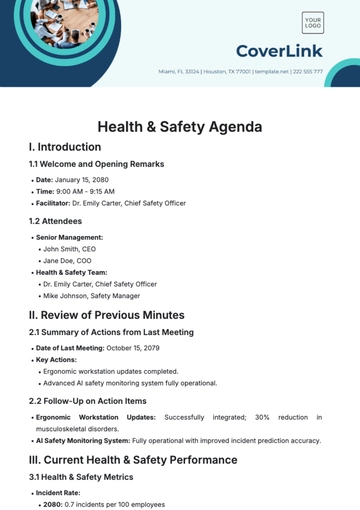Free Advanced Health & Safety Training Planning
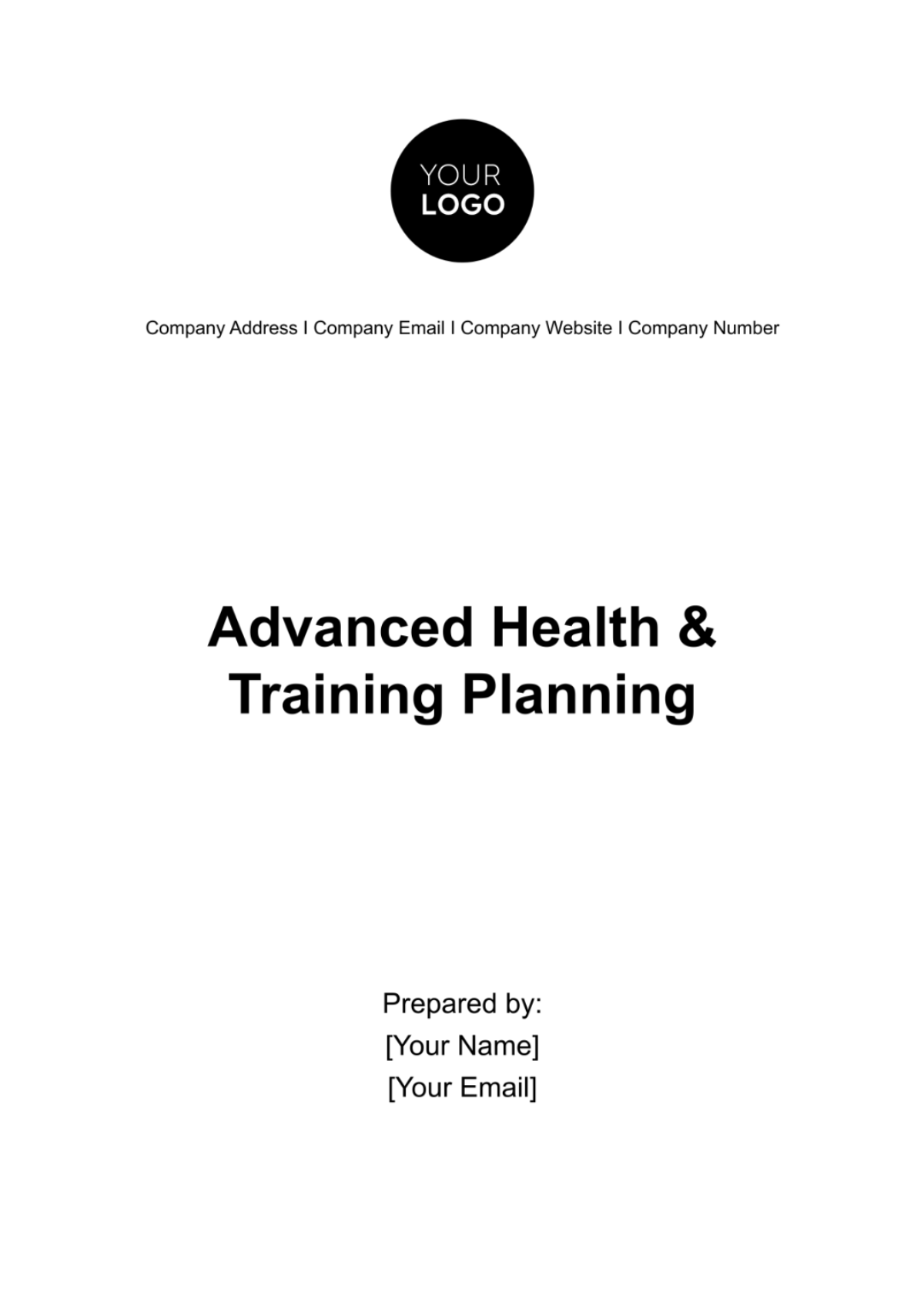
Introduction
A. Background
In light of recent workplace incidents and the increasing importance of employee safety, [Your Company Name] has recognized the need for advanced health and safety training. Over the past decade, there has been a growing concern for the well-being of our employees and a commitment to fostering a culture of safety within our organization. This advanced training program aims to further strengthen our safety practices and ensure the well-being of our workforce.
B. Purpose
The primary purpose of this training planning is to elevate our health and safety standards to the highest level. By providing advanced training, we intend to empower our employees with the knowledge and skills necessary to identify and mitigate risks effectively. This program seeks to instill a safety-first mindset among our workforce, reduce workplace accidents, and enhance the overall health and safety culture within [Your Company Name].
C. Scope
The scope of this training program encompasses all employees of [Your Company Name] across multiple geographic locations. It focuses on a comprehensive range of health and safety topics, including but not limited to hazard identification, emergency response, ergonomics, and compliance with relevant laws and regulations. The program is designed to cater to both new hires and existing employees who require advanced training to excel in their roles.
D. Objectives
The key objectives of this advanced health and safety training program are as follows:
To reduce workplace injuries and accidents by at least [20%] within the next year.
To enhance safety awareness and encourage employees to actively participate in safety initiatives.
To achieve full compliance with all relevant health and safety regulations and standards.
To empower employees with the skills and knowledge needed to respond effectively to emergencies.
To foster a culture of continuous improvement in health and safety practices.
Training Needs Assessment
A. Identification of Training Needs
The training needs assessment began with a comprehensive review of workplace incidents, near misses, and safety reports over the past five years. This data was analyzed to identify trends and areas with the highest incidence of accidents or incidents. Employee feedback, surveys, and suggestions were also considered.
B. Risk Assessment
A thorough risk assessment was conducted across all our facilities and operations. This assessment involved identifying potential hazards, assessing their severity and likelihood, and prioritizing them based on risk levels. High-risk areas and activities were pinpointed for targeted training.
C. Legal Requirements
We reviewed all relevant federal, state, and local health and safety regulations to ensure compliance. Any gaps in compliance were noted, and training topics were aligned with legal requirements.
D. Existing Competencies
A skills inventory was conducted to gauge the current health and safety competencies of our employees. This helped identify areas where employees already had strong knowledge and skills and areas where further training was required.
E. Gaps Analysis
The gaps analysis revealed several areas where training was needed to bridge the disparity between current competencies and the desired level of expertise. These gaps formed the basis for developing the training modules and content for this program.
Training Program Design
A. Training Goals and Outcomes
The overarching goal of the advanced health and safety training program is to create a safer work environment by equipping our employees with the knowledge and skills necessary to identify, assess, and mitigate risks effectively. The desired outcomes of this training include:
Increased awareness of workplace hazards and their potential consequences.
Enhanced competency in the use of safety equipment and procedures.
Improved ability to respond to emergencies promptly and effectively.
Development of a safety-first mindset among all employees.
Achievement of a significant reduction in workplace accidents and injuries.
B. Training Modules
The training program will consist of several modules, each addressing specific aspects of health and safety. These modules include but are not limited to:
Hazard Identification and Risk Assessment
Emergency Response Procedures
Ergonomics and Workplace Health
Chemical and Hazardous Materials Handling
Safety Regulations and Compliance
Incident Reporting and Investigation
Health and Safety Leadership
C. Training Methods
To ensure effective learning, a combination of training methods will be employed. This includes:
Interactive workshops and hands-on training for practical skills development.
E-learning modules and online resources for self-paced learning.
Simulation exercises to simulate real-life emergency situations.
Group discussions and case studies to encourage active participation and problem-solving.
D. Training Resources
The successful execution of this training program will require various resources, including:
Qualified trainers and subject matter experts in health and safety.
Training materials, such as manuals, videos, and presentations.
Access to training facilities equipped with necessary safety equipment.
Technological resources for online training delivery.
Budget allocation for training expenses.
E. Schedule and Duration
The training program will be conducted over [6 months], with multiple sessions to accommodate different employee groups. The schedule will be distributed across months, ensuring minimal disruption to regular operations.
F. Budget Allocation
A budget of [$100,000] has been allocated for this training program. This budget covers expenses related to trainer fees, training materials, facility rentals, technology infrastructure, and any other associated costs. The budget allocation has been carefully structured to ensure the successful implementation of the training program.
Training Material Development
A. Content Creation
The development of training content is a critical component of this planning. Training materials will be created to align with the identified training modules. Content will be informative, engaging, and tailored to the specific needs of our employees. It will include detailed explanations, practical examples, and visuals to enhance comprehension.
B. Training Manuals
Comprehensive training manuals will be prepared for each module. These manuals will serve as valuable reference materials for participants during and after the training. They will contain step-by-step instructions, safety guidelines, and relevant diagrams.
C. Visual Aids
Visual aids, such as infographics, charts, and videos, will be developed to complement the training materials. These aids will simplify complex concepts, making them more accessible to all participants. Visuals will be designed to reinforce key safety messages.
D. Interactive Tools
Interactive tools and exercises will be integrated into the training materials to facilitate active learning. Participants will engage in practical exercises, quizzes, and simulations to apply their knowledge in real-life scenarios.
E. Language and Accessibility
Training materials will be available in multiple languages to cater to our diverse workforce. Accessibility considerations, such as providing materials in alternative formats for employees with disabilities, will also be addressed to ensure inclusivity.
Training Delivery
A. Trainers Selection
Highly qualified trainers with expertise in health and safety will be carefully selected to deliver the training. Trainers will possess relevant certifications and extensive practical experience in the field. They will undergo a thorough orientation to align their training approach with our organization's values and objectives.
B. Training Facilities
Safe and conducive training facilities will be chosen to ensure an optimal learning environment. These facilities will meet all safety standards and provide ample space for practical exercises and demonstrations. Access to essential safety equipment and resources will be guaranteed.
C. Equipment and Technology
All necessary training equipment and technology will be made available. This includes personal protective equipment, first-aid kits, fire safety equipment, and any specialized tools required for training modules. Additionally, technology such as audiovisual equipment and computer systems will support the delivery of online and multimedia components of the training.
D. Safety Measures during Training
The safety of participants during training sessions is paramount. Protocols will be established to ensure that all safety precautions are taken. This includes regular safety briefings, adherence to safety procedures during practical exercises, and the presence of trained first-aid responders during training sessions.
E. Pre-training Briefing
Before the commencement of training, all participants will receive a pre-training briefing. This briefing will outline the training objectives, expectations, and safety protocols. It will also provide an opportunity for participants to ask questions and voice concerns.
Participant Registration and Communication
A.Registration Process
A streamlined registration process will be established to facilitate participant enrollment. This process will include an online registration portal accessible through [Your Company Website], ensuring ease of registration for employees. Participants will be required to provide their details, including contact information and department affiliation.
B. Participant Information
Detailed participant information will be collected, including their current roles, prior health and safety training experience, and any specific needs or accommodations required. This information will help tailor the training to individual needs and ensure a personalized learning experience.
C. Communication Plan
A comprehensive communication plan will be implemented to keep participants informed throughout the training program. This plan will include regular email updates, reminders, and announcements via [Your Company Social Media] and the company intranet. Clear communication channels will be established for participants to seek assistance or raise questions.
D. Confirmation and Reminders
Participants will receive confirmation of their enrollment upon registration. Additionally, timely reminders will be sent before each training session to ensure attendance and preparedness. These reminders will include details of the session, location, and any required materials or equipment.
Monitoring and Evaluation
A.Training Progress Tracking
To ensure the effectiveness of the training program, a robust progress-tracking system will be implemented. This system will record the attendance and participation of each participant in every training session. Additionally, progress assessments will be conducted at key milestones to gauge knowledge retention and skill development.
B. Feedback Mechanisms
Feedback from participants is invaluable for continuous improvement. Regular feedback sessions will be scheduled to gather insights into the training experience. Participants will have the opportunity to provide feedback on training content, trainers, materials, and overall program effectiveness.
C. Evaluation Criteria
Specific evaluation criteria will be established to assess the success of the training program. These criteria will include the reduction in workplace incidents, improved safety compliance, participant feedback scores, and the successful completion of assessments. Regular evaluations will be conducted to measure progress against these criteria.
D. Effectiveness Assessment
An effectiveness assessment will be carried out after the training program to determine its overall impact. This assessment will involve comparing pre-training and post-training data on key performance indicators related to health and safety. The results will be analyzed to gauge the program's effectiveness in achieving its objectives.
E. Continuous Improvement
The insights gathered from progress tracking, feedback, and effectiveness assessments will be used to drive continuous improvement in the training program. Recommendations for enhancements or modifications to training modules, delivery methods, or materials will be implemented to ensure that the program remains relevant and effective.
Documentation and Reporting
A. Training Records
Comprehensive records of all training activities will be maintained. These records will include participant lists, training schedules, attendance sheets, assessment results, and feedback reports. Proper documentation ensures transparency and compliance with regulatory requirements.
B. Incident Reporting
In addition to training records, an incident reporting system will be in place. This system allows employees to report any safety-related incidents, near misses, or hazards they encounter during their work. All reported incidents will be thoroughly investigated, and corrective actions will be taken as needed.
C. Compliance Reports
Regular compliance reports will be generated to track our organization's adherence to health and safety regulations. These reports will provide a snapshot of our compliance status, highlighting any areas that require attention or improvement. Compliance reports will be shared with relevant regulatory bodies as necessary.
D. Partner Company Reports
For our secondary party, [Your Partner Company Name], reports on the progress and effectiveness of the training program will be shared periodically. These reports will include participant performance, incident reports, and any collaboration-related updates. Open communication with our partner company is essential to ensure alignment and mutual success.
E. Legal Documentation
All legal documentation related to health and safety training, including training materials, certifications, compliance records, and incident reports, will be diligently maintained. These documents will be readily accessible for audits and inspections to demonstrate our commitment to compliance and employee safety.
Closure and Certification
A.Final Assessments
After the advanced health and safety training program, participants will undergo final assessments to evaluate their knowledge and skills. These assessments will be designed to measure their proficiency in the topics covered throughout the training. Successful completion of these assessments will be a key requirement for certification.
B.Certification Process
Upon successful completion of the final assessments, participants will receive certifications to recognize their achievement and competency in advanced health and safety. These certifications will be issued by [Your Company Name] and will serve as official endorsements of their qualifications in this critical field.
C.Recognition and Rewards
To encourage active participation and excellence in the training program, [Your Company Name] will implement a recognition and rewards system. Participants who excel in assessments, demonstrate exceptional commitment to safety, or contribute significantly to the program's success may receive special recognition and rewards. These incentives will not only motivate participants but also reinforce the importance of a safety culture.
D. Closing Ceremony
A closing ceremony will mark the culmination of the advanced health and safety training program. This event will serve as a platform to acknowledge the achievements of participants, distribute certifications, and recognize individuals who have made outstanding contributions. The ceremony will also provide an opportunity to reflect on the journey towards enhanced safety within [Your Company Name] and to reinforce the commitment to maintaining a safe workplace.
- 100% Customizable, free editor
- Access 1 Million+ Templates, photo’s & graphics
- Download or share as a template
- Click and replace photos, graphics, text, backgrounds
- Resize, crop, AI write & more
- Access advanced editor
Elevate your health and safety training with Template.net's Advanced Health & Safety Training Planning Template. This editable and customizable tool, powered by our Ai Editor Tool, facilitates the creation of comprehensive training plans. Empower your organization to enhance safety measures effectively. Trust Template.net for reliable solutions in advanced health and safety training planning.

